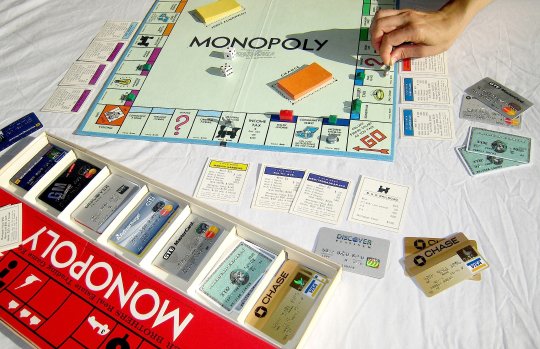Don’t Throw It Out!
October 20, 2009 at 7:23 am | Posted in Tips | 18 Comments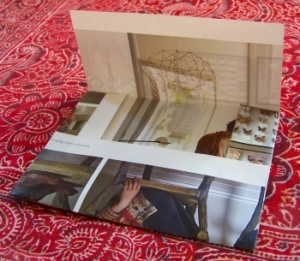 Our friend David sends along this link to a recycled-paper craft idea from Greenprophet, a site covering environmental issues around the Middle East:
Our friend David sends along this link to a recycled-paper craft idea from Greenprophet, a site covering environmental issues around the Middle East:
“With all of the colorful designs on a lot of junk mail catalogs and solicitations, many of them can make unique envelopes. They are extremely easy to make, and these one-of-a-kind, funky envelopes are sure to put a smile on your addressee’s (and maybe even your postman’s) face.
For this project you will need:
1 sheet of junk mail paper or 1 sheet out of a junk mail catalog
Scissors
Glue
Card/Letter you want to put in the envelope
1. Place the item you want to mail (the card or letter) on the center of your junk mail sheet. Make sure that the side of the paper you want to appear as the outside of the envelope is facing down.
2. Fold the sides of the sheet in around the card or letter – fold straight creases along the top, bottom, left, and right. This should create a grid-like pattern of folds on the sheet. (See the picture on the right.)
3. Use your scissors to cut out the four corners that were created by the folds. This should leave you with a cross-like shaped paper that has a center for the card or letter you want to mail and 4 flaps surrounding it. (Check out the picture on the left.)
4. Glue one of the larger flaps to the two side flaps to create a pocket for the item you want to mail. Once the glue has dried, place your letter in and seal the envelope by gluing the remaining flap closed.
If you are hand-delivering this envelope, then you don’t have to worry how sturdy your paper is. But if you plan on mailing the envelope (especially if it’s to an international location), then you may want to line the inside of the envelope with some additional junk mail paper. Magazine or catalog papers can be beautiful, but they can also be thin so before gluing the flaps closed in step 4, glue a cut out piece of paper that is slightly smaller than the main section of the envelope to the inside.”
Don’t Throw Out Those Old Pillows, Either
September 26, 2009 at 9:01 am | Posted in Tips | 3 Comments Here’s a handy tip from Green Prophet: “Pillows are made of not the best synthetic material for landfills. That plus the fact that pillow manufacturing companies recommend getting new ones every 6 months to 2 years. That can lead to a lot of unhealthy non-degradable fluff filling up our dumps.
Here’s a handy tip from Green Prophet: “Pillows are made of not the best synthetic material for landfills. That plus the fact that pillow manufacturing companies recommend getting new ones every 6 months to 2 years. That can lead to a lot of unhealthy non-degradable fluff filling up our dumps.
“The good news is that there are plenty of wonderful ways to reuse your old pillows, just make sure that you wash them first…
“Use the stuffing to pad new pillows making them even firmer! Donate them to a local animal shelter. What isn’t fluffy enough for you is a pillow heaven for an unwanted puppy. Make decorative pillows for your living room and use the old pillows to stuff them. Save them for the next time you pack. Your dishes will never have a smoother move.”
How to Scavenge Glasses: Meet Ira Mitchell, Cheap-Glasses Guru
August 24, 2009 at 9:50 am | Posted in Tips | 24 Comments One of the most life-changing scavenging sites online is Glassy Eyes, devoted to the revolutionary idea of BUYING PRESCRIPTION EYEGLASSES ONLINE for half, one-fourth, or even one-tenth of what they’d cost you in a brick-and-mortar optician’s shop. I know — it sounds impossible. But more and more online eyeglasses companies are popping up all the time; Glassy Eyes keeps track of them and hosts dozens of forums where users discuss their experiences with each. Because of my severe astigmatism and strong prescription, glasses normally cost me over $300 per pair, with absolutely no frills. But thanks to Glassy Eyes, last year I bought a pair of progressive bifocals from Zenni Optical for about $50. (Zenni’s prices start at an amazing $8 for single-vision glasses. Mine were more because they’re bifocals.) They’re not perfect — a bit of distortion at the outer edges, and the middle range is a smidge too narrow — but for distance and for reading, they’re sharp and clear. As backups, they’ve been absolutely great.
One of the most life-changing scavenging sites online is Glassy Eyes, devoted to the revolutionary idea of BUYING PRESCRIPTION EYEGLASSES ONLINE for half, one-fourth, or even one-tenth of what they’d cost you in a brick-and-mortar optician’s shop. I know — it sounds impossible. But more and more online eyeglasses companies are popping up all the time; Glassy Eyes keeps track of them and hosts dozens of forums where users discuss their experiences with each. Because of my severe astigmatism and strong prescription, glasses normally cost me over $300 per pair, with absolutely no frills. But thanks to Glassy Eyes, last year I bought a pair of progressive bifocals from Zenni Optical for about $50. (Zenni’s prices start at an amazing $8 for single-vision glasses. Mine were more because they’re bifocals.) They’re not perfect — a bit of distortion at the outer edges, and the middle range is a smidge too narrow — but for distance and for reading, they’re sharp and clear. As backups, they’ve been absolutely great.
Those of us with less-than-perfect vision know that eyeglasses are a scavenger’s nightmare. Maybe, just maybe, you can find the occasional pair of secondhand frames in a thrift shop or at a yard sale, but such finds are incredibly rare — largely because the Lions Club tends to get first dibs on all pairs of prescription spectacles donated to thrift shops, which the club then gives to Doctors Without Borders, which then distributes them among the needy overseas. And even if you find those once-in-a-blue-moon secondhand frames, the chances of actually liking them — of their being the right shape, size, style, and color — are slim beyond slim. Frames at brick-and-mortar opticians’ shops tend to start at around $100, which is ridiculous considering that you’re just getting a few ounces of plastic or wire with a couple of hinges attached. AND THAT’S JUST THE COST OF THE FRAMES. The markup on lenses is shocking too, according to Ira Mitchell, the guy behind Glassy Eyes.
Mitchell is a scavengers’ hero, and he was kind enough to consent to an interview.
Purchased online, “my typical pair costs between $30 and $60 with the coatings and the discounts,” Mitchell says. Over the last three years, he’s bought around forty pair — because, at that price, he can.
Q: Tell me something about the markups commonly applied at opticians’ shops. When it comes to frames and various types of lenses, what kind of profit margin are we talking about?
A: There are a number of examples that have been passed my way to further enforce my view of the fleecing we’ve received at the hands of the optical shops. Some are rather damning. Here is my favorite, by far, from an optician in Texas — I found it on an online optical board: “A pair of SV (single vision) stock poly Alize cost me $34, and carry a 2 year warranty. We sell ’em all day long for $199/pair, for a profit of $165/pair. Our capture rate for AR (anti-reflective coating) is about 90%. Also stock poly non coated, cost $6/pair and sell for $109…. Now show me the math where you can beat the $165 profit on a pair of SV (single vision) lenses. If you can, I’ll still love you in the morning.”
After I posted it, he got in touch with me directly — very angrily I should add. A creepy dude to be sure.
A retired Minneapolis optician sent me the following: ‘As a retired Minneapolis optician I can tell you first hand that we bought our lenses in bulk and most single vision lenses cost less than $2.00 a pair, Bifocals and progressives cost us as much as $6.00 a pair. Frames… name brand, up to $10.00, same quality generics cost us much less. Online is the way I buy all of my eyewear, New glasses in under two weeks!’
I originally thought that the markup was in the frames. The range in prices from what my eye doctor called ‘welfare frames’ to the designer frames was from $30 to whatever-you-want-to-pay. I figured they pay salaries and such from the cost of the designer frame with the $190 price tag. There is no appreciable functional or material difference, but the cost to the consumer is anywhere from four to ten times more.
It turns out that they’re making ridiculous margins on the frames, the lenses, and the coatings.
Q: GlassyEyes’ motto is “Shattering the eyeglasses scam.” That’s a pretty strong charge. Why do you call it a scam?
A: $400 for a pair of eyeglasses at a store, versus a remarkably similar pair online for, say, $30? These companies, apart from the few mom-and-pop joints scratching for survival in the small towns, are gobbling each other up in an effort to monopolize the market. Look at the eyeglasses chains in your city. I bet the vast majority are owned by one company. [That company is Luxottica; Mitchell provides this link.]
Stack the deck enough and you won’t have any competition to help moderate prices. The internet is again proving itself as a great equalizer.
Q: What do you say to folks who ask: Are you trying to put regular brick-and-mortar opticians out of business?
A: Only the ones who continue to rip people off and refuse to adapt to a new economy. I’ve stated early on that I think there is an economical model for a low-cost brick-and-mortar eyeglasses store. A lot of it relies on a sea change in our thinking about eyeglasses. That is starting to happen and someone will figure out a way to serve the masses, either online or off…. I expect big changes in the next couple of years.
Q: Have you been confronted/questioned/challenged by any representatives of the optical industry?
A: Constantly. … [But] as the site’s popularity grows, these confrontations are diminishing. I think they realize that there is little to argue about any longer — the toothpaste is out of the tube. They’re hoping that more people don’t do the research and that this will remain a ‘niche.’
Q: Buying anything online entails a certain amount of risk. Buying glasses anywhere entails a certain amount of risk. Given the degree of risk, how do you advise online glasses-shoppers to proceed? What should they be most aware of, cautious about, etc.?
A: I’ve lost count of the number of eyeglasses orders I’ve placed online … and I’ve only gotten two ‘bad’ pairs…. Of the previous five pairs I bought at LensCrafters, one was made with the lenses flipped, and another with Ray-Ban frames never fit right. There is a risk to ordering online, but I much prefer my 95% online success to my 60% at LensCrafters.
I have four things I preach to newcomers:
1) I mitigated my initial risk by ordering two pairs — each from a different retailer. I figured at least one would be OK. Do the same.
2) Check, double-check, and triple-check the prescription you enter online. Be very sure the numbers on that prescription card match what you’ve entered on that form.
3) Use the numbers stamped on the inside of an existing pair as a guideline on those first few pairs. All of the sites explain what these numbers mean. You can branch out from this once you’re comfortable and understand the process better.
4) Only order from reputable dealers. There are two places that I cover that are very, very good at making customers happy. When problems happen — and they do — the separation comes from the retailers that stand behind their product. I think it’s fair to pay a little bit more for that.
Ten Practical Uses for Your Credit Cards
June 2, 2009 at 9:44 am | Posted in Pop culture, Recycling, Tips | 73 CommentsStop using your credit cards. They’ll just get you into debt.
But wait: Don’t throw them away. Just stop using them as they were designed to be used — that is, to pay for stuff. Save the actual cards. Because they’re useful in all sorts of ways you might never have considered.
Here are ten ways we’ve repurposed our unwanted credit cards. But the possibilities are infinite. How would you use yours? Post ideas and links in the comments section below, or email pictures of your handiwork here.
(Click each photo below to see the full-size image. Card numbers are blurred; you can never be too careful these days.)
Ten Practical Uses for Your Credit Cards
Snow goggles
 (Also formerly known as “Eskimo sunglasses.”)
(Also formerly known as “Eskimo sunglasses.”)
Burglary tool
 The original alternate use for credit cards.
The original alternate use for credit cards.
Golf putter
 Make sure to have the back of the card facing outwards; otherwise, the protruding card numbers will make it hard to aim! (This really works — click here to see a video of the credit-card putter in action.)
Make sure to have the back of the card facing outwards; otherwise, the protruding card numbers will make it hard to aim! (This really works — click here to see a video of the credit-card putter in action.)
Coinage
 If the economy collapses, we’ll have to use something for money.
If the economy collapses, we’ll have to use something for money.
Credicopter
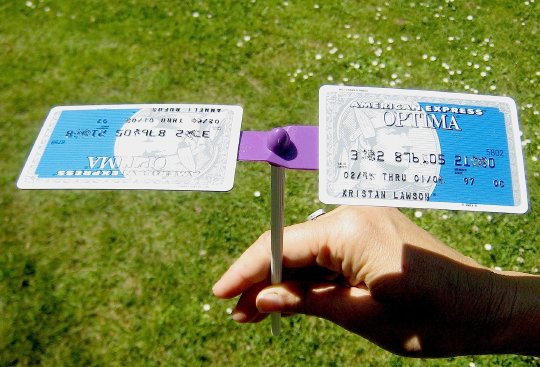 A hand-held mini-helicopter augmented with credit cards for extra lift. Click here to see the credicopter actually flying!
A hand-held mini-helicopter augmented with credit cards for extra lift. Click here to see the credicopter actually flying!
Cocaine cutter
 The other original alternate use for credit cards.
The other original alternate use for credit cards.
(Note to law enforcement: Baking powder. Not actual cocaine.)
How to Make a Credit-Card Bracelet
May 14, 2009 at 2:49 pm | Posted in Recycling, Tips | 104 CommentsEveryone knows that credit cards are for buying stuff you can’t afford. You get the stuff now, but don’t have to pay until, uh, later. Credit cards are based on the obsolete premise that in the future you’ll have more money than you have today. In the current economy, using credit cards to rack up high-interest debt is the world’s dumbest idea. The time has come to throw that credit card away —
Or to give it a whole new life as something else. Instead of using your credit card to buy a bracelet, why not turn the card into the bracelet? Pretty much useless for their original intended purpose, credit cards are like the vanished currency of a long-lost civilization. And just as humans have always adorned themselves with shiny accessories made of old coins, the time has come to do the same with credit cards. More lustrous than real gold, durable yet permeable, “gold cards,” “platinum cards” and American Express cards in particular make glorious jewelry. Repurpose these relics into tomorrow’s gems.
MAKE YOUR CREDIT-CARD BRACELET
A step-by-step photo guide
Before you get started, you will of course need to salvage an old credit card that you’ve discarded — or a new credit card that you’re about to stop using!
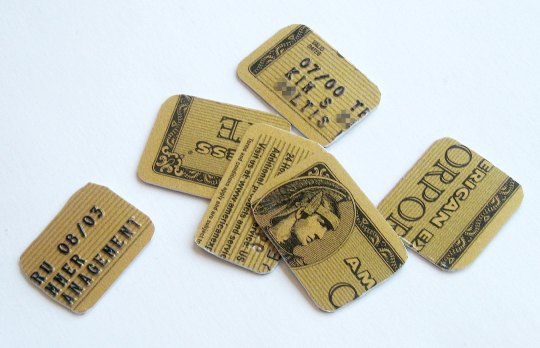
1. Cut the card into your chosen shapes: squares, rectangles, and ovals work best. Try to get at least six pieces out of each card.
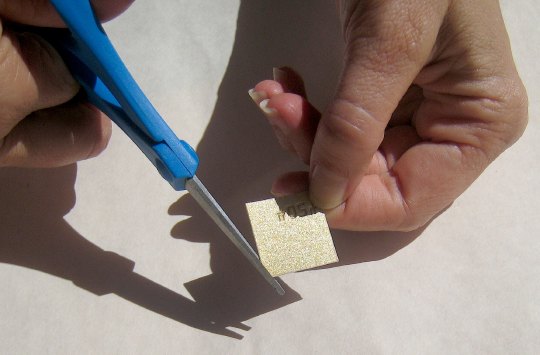
2. If you’ve chosen squares or rectangles, trim their corners to form curves. (A bracelet that jabs you or catches on things is not a fun bracelet.) Arrange the pieces in an order that pleases you.
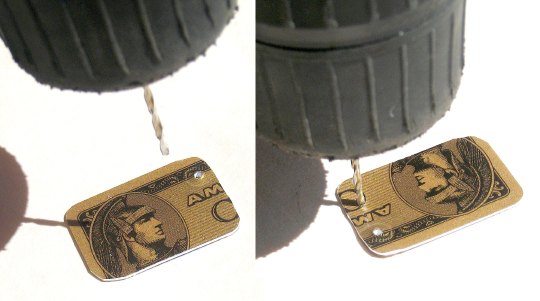
3. Using an electric drill, make holes in each card-piece through which loops will be inserted. Ensure that these holes are close enough to the edges of the plastic to accommodate at least half the diameter of each loop. Also ensure that the holes are big enough to allow the loops smooth movement. (Lacking a drill, you can make holes in the pieces using a hammer and a small nail, but the impact will create unwieldy raised edges around the holes on the reverse side.) Interior pieces need two holes at each end (equalling four holes per piece); the terminating pieces need two holes on one edge and one central hole on the final outer edge (equalling three holes each) for affixing the clasp mechanism.
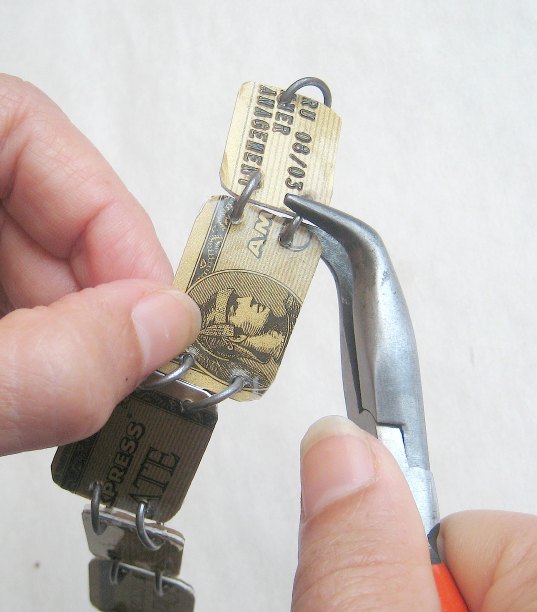
4. Insert loops through holes to connect all the pieces. Squeeze the loops tight so that they won’t slip off. Affix clasp mechanism of your choice.
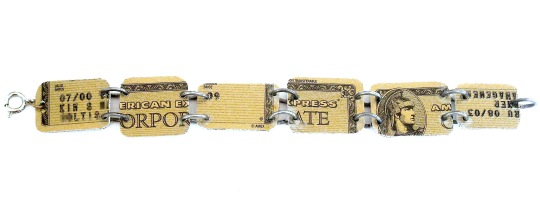
Voila! The final product.
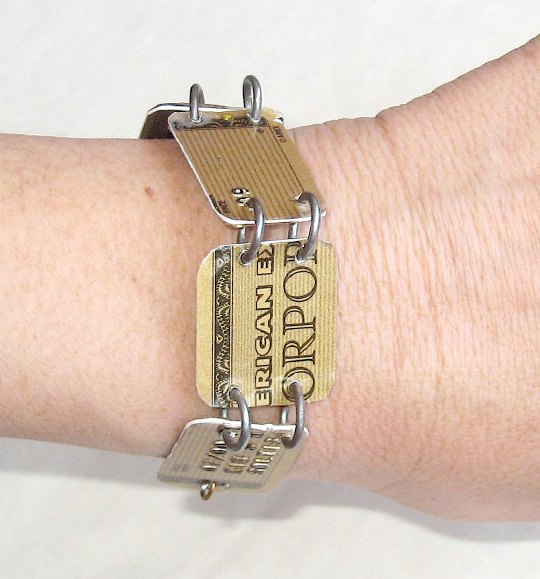
5. Enjoy your finished credit-card bracelet.
Other types of jewelry can also be made with credit cards.
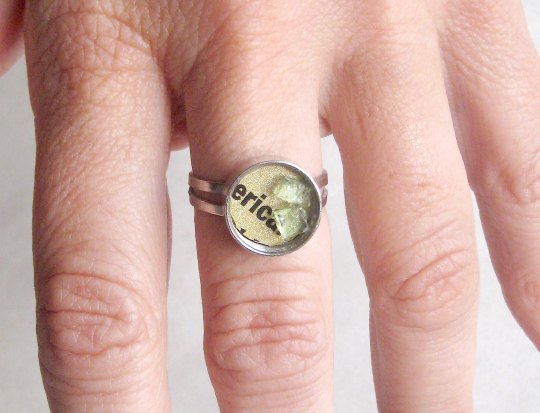
The credit-card ring — with windshield-glass “gems” scavenged from the scene of an auto burglary.

Credit-card earrings. Use your imagination to find ways of incorporating cards into other jewelry (or jewelry parts) that you’ve scavenged.
Just Do It
April 10, 2009 at 7:12 am | Posted in Tips | Leave a comment Analyzing and catastrophizing the tanking economy is a bit of a luxury in the midst of … well, a tanking economy. Who has time for theory when we’ve got corners to cut and cash to save? Life on a $hoestring Budget is a blog packed with practical projects and inspiring ideas, from making baby blankets out of holey old sweaters to lowering your home’s hot-water temperature to acquiring free (and old and dilapidated, but still) houses being given away by developers who are subdividing property. Comb LOASB’s current postings and delve into its archives and you’ll emerge energized.
Analyzing and catastrophizing the tanking economy is a bit of a luxury in the midst of … well, a tanking economy. Who has time for theory when we’ve got corners to cut and cash to save? Life on a $hoestring Budget is a blog packed with practical projects and inspiring ideas, from making baby blankets out of holey old sweaters to lowering your home’s hot-water temperature to acquiring free (and old and dilapidated, but still) houses being given away by developers who are subdividing property. Comb LOASB’s current postings and delve into its archives and you’ll emerge energized.
Welcome to the Scavenging Blog!
July 13, 2007 at 1:37 am | Posted in Adventures, Book excerpts, Celebrities, Deals, Finds, News, Philosophy, Pop culture, Recycling, Reviews, Tips, Uncategorized, Videos | 1 CommentAre you a scavenger? We are. And we think there’s a lot more of us out there than anybody realizes.
Scavenging is the first and only blog devoted exclusively to the concept of the scavenger. And we’ll also explore the philosophy of scavenging as a lifestyle (or a hobby), and the critical role it plays in the world at large.
So send us your tales of scavenging, your greatest triumphs and most bitter regrets. And start thinking of yourself as a scavenger first, above all else.
Create a free website or blog at WordPress.com.
Entries and comments feeds.
